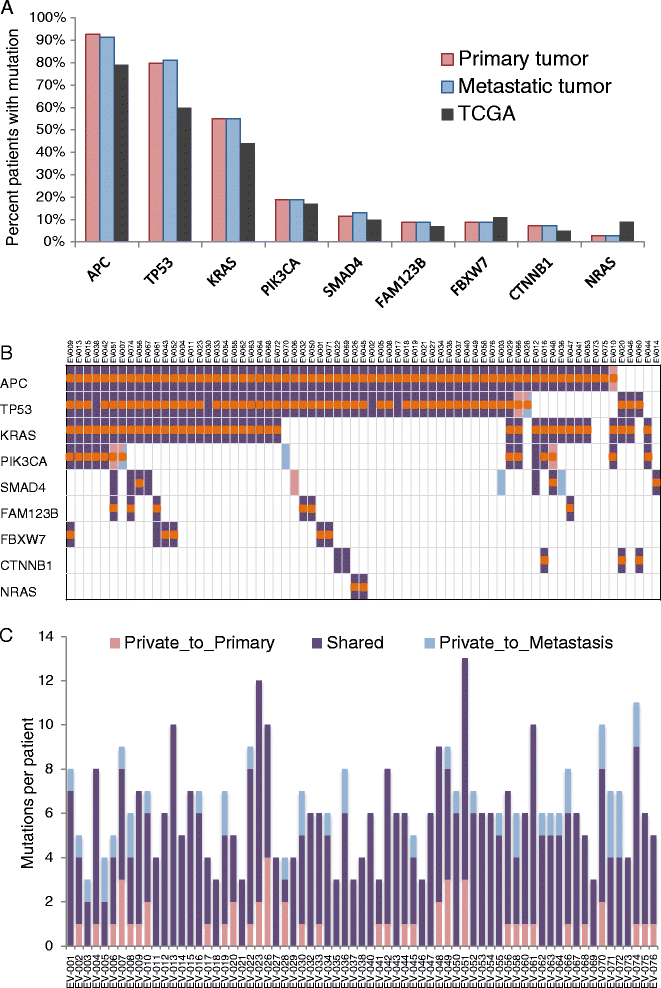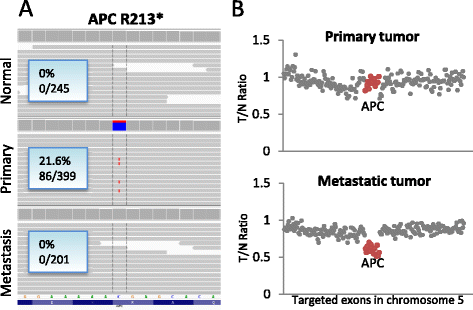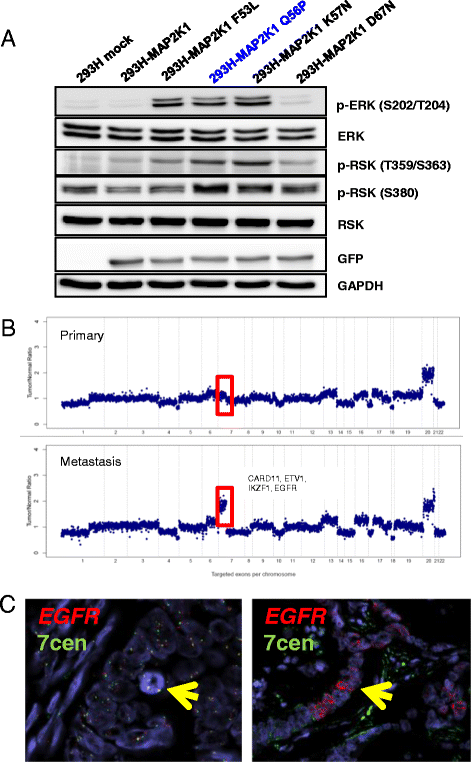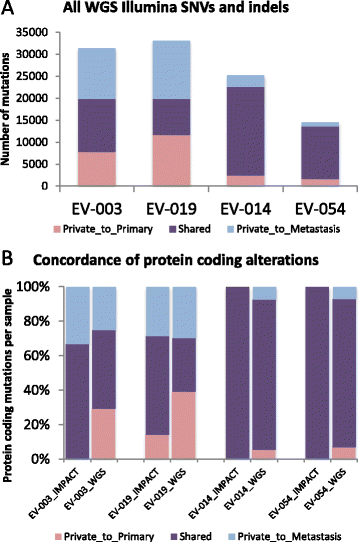Comparative sequencing analysis reveals high genomic concordance between matched primary and metastatic colorectal cancer lesions
- PMID: 25164765
- PMCID: PMC4189196
- DOI: 10.1186/s13059-014-0454-7
Comparative sequencing analysis reveals high genomic concordance between matched primary and metastatic colorectal cancer lesions
Abstract
Background: Colorectal cancer is the second leading cause of cancer death in the United States, with over 50,000 deaths estimated in 2014. Molecular profiling for somatic mutations that predict absence of response to anti-EGFR therapy has become standard practice in the treatment of metastatic colorectal cancer; however, the quantity and type of tissue available for testing is frequently limited. Further, the degree to which the primary tumor is a faithful representation of metastatic disease has been questioned. As next-generation sequencing technology becomes more widely available for clinical use and additional molecularly targeted agents are considered as treatment options in colorectal cancer, it is important to characterize the extent of tumor heterogeneity between primary and metastatic tumors.
Results: We performed deep coverage, targeted next-generation sequencing of 230 key cancer-associated genes for 69 matched primary and metastatic tumors and normal tissue. Mutation profiles were 100% concordant for KRAS, NRAS, and BRAF, and were highly concordant for recurrent alterations in colorectal cancer. Additionally, whole genome sequencing of four patient trios did not reveal any additional site-specific targetable alterations.
Conclusions: Colorectal cancer primary tumors and metastases exhibit high genomic concordance. As current clinical practices in colorectal cancer revolve around KRAS, NRAS, and BRAF mutation status, diagnostic sequencing of either primary or metastatic tissue as available is acceptable for most patients. Additionally, consistency between targeted sequencing and whole genome sequencing results suggests that targeted sequencing may be a suitable strategy for clinical diagnostic applications.
Figures




References
-
- Gerlinger M, Rowan AJ, Horswell S, Larkin J, Endesfelder D, Gronroos E, Martinez P, Matthews N, Stewart A, Tarpey P, Varela I, Phillimore B, Begum S, McDonald NQ, Butler A, Jones D, Raine K, Latimer C, Santos CR, Nohadani M, Eklund AC, Spencer-Dene B, Clark G, Pickering L, Stamp G, Gore M, Szallasi Z, Downward J, Futreal A, Swanton C. Intratumor heterogeneity and branched evolution revealed by multiregion sequencing. N Engl J Med. 2012;366:883–892. doi: 10.1056/NEJMoa1113205. - DOI - PMC - PubMed
-
- Yachida S, Jones S, Bozic I, Antal T, Leary R, Fu B, Kamiyama M, Hruban RH, Eshleman JR, Nowak MA, Velculescu VE, Kinzler KW, Vogelstein B, Iacobuzio-Donahue CA. Distant metastasis occurs late during the genetic evolution of pancreatic cancer. Nature. 2010;467:1114–1117. doi: 10.1038/nature09515. - DOI - PMC - PubMed
-
- Jones S, Chen WD, Parmigiani G, Diehl F, Beerenwinkel N, Antal T, Traulsen A, Nowak MA, Siegel C, Velculescu VE, Kinzler KW, Vogelstein B, Willis J, Markowitz SD. Comparative lesion sequencing provides insights into tumor evolution. Proc Natl Acad Sci U S A. 2008;105:4283–4288. doi: 10.1073/pnas.0712345105. - DOI - PMC - PubMed
-
- Vermaat JS, Nijman IJ, Koudijs MJ, Gerritse FL, Scherer SJ, Mokry M, Roessingh WM, Lansu N, de Bruijn E, van Hillegersberg R, van Diest PJ, Cuppen E, Voest EE. Primary colorectal cancers and their subsequent hepatic metastases are genetically different: implications for selection of patients for targeted treatment. Clin Cancer Res. 2012;18:688–699. doi: 10.1158/1078-0432.CCR-11-1965. - DOI - PubMed
Publication types
MeSH terms
Substances
Grants and funding
LinkOut - more resources
Full Text Sources
Other Literature Sources
Medical
Research Materials
Miscellaneous

